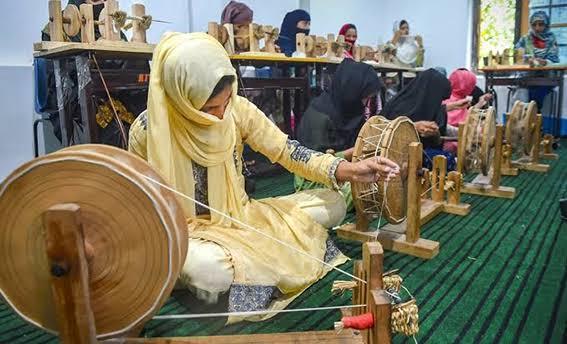
The Return Of The Loom: Kashmir's Craft Economy Rising Again
The Return of the Loom: Kashmir's Craft Economy Rising Again
By Malik Daniyal
In Srinagar's old alleys, the clatter of looms has grown faint. Once-bustling karkhanas now stand locked or turned into storage spaces.
For centuries, Kashmiri handicrafts have carried history, preserved identity, and sustained families. From Pashmina and Kani shawls to papier-mâché and walnut woodwork, these crafts supported generations.
Today, they stand at the edge of decline, pressured by globalization, technology, and neglect.
Handmade with patience and precision, each Kashmiri craft is a cultural heirloom. The warmth of a Pashmina, the delicate Sozni embroidery, and the vivid strokes of papier-mâché tell a story.
Read Also Video: How To Build Sustainable Economy In Kashmir Kashmir's First Printmaking Studio Brings India's Master Artists HomeYet in today's fast-paced markets, their prestige is slipping, leaving artisans to fight for survival.
For decades, handicrafts were cultural expression as well as economic backbone. At their peak, government records estimate more than 2.5 lakh artisans were engaged directly or indirectly in the sector. Whole communities revolved around these crafts, where weaving, carving, or embroidering was both livelihood and legacy.
Now, signs of revival are emerging.
In traditional craft clusters, like Nawa Kadal, Zaina Kadal, and Kanihama, the hum of charkhas is being heard again. A major reason is the growing use of Geographical Indication (GI) tags, which give authenticity new economic value.
From only 175 GI labels in 2014, the number rose to over 13,900 by 2022-23. Exports, too, nearly doubled in two years, from ₹563 crore in 2021-22 to around ₹1,162 crore in 2023-24.
For many artisans, this has brought not just hope but steady earnings.
But beneath the upbeat figures lies a harsher reality. While 92% of artisans rely almost entirely on handicrafts, many barely make enough to cover daily needs. Wages remain stagnant, unchanged for decades, and payments are often delayed.
Intermediaries profit while loom workers struggle. Cheap, machine-made imitations further undercut original work, hitting Pashmina, carpets, and shawls the hardest.
The toll is heavier on women.
Once nearly half the workforce, their participation has dropped sharply. By 2017, some 10,000 women spinners had left the craft because of low pay. Traditional spinning and dehairing, once their domain, had nearly gone silent. Recent revival efforts, however, are pulling some back.
At initiatives like“Zaevuyl,” spinners now earn around ₹14,000 a month, while weavers can make about ₹20,000, a sharp rise from earlier rates.
Grassroots interventions are also reshaping the craft. The Centre for Excellence in Narwara, backed by the Aditya Birla Group and led by entrepreneur Mujtaba Kadri, has revived women's work with better pay and new opportunities.
QR-coded GI tags, about 20,000 on Pashmina shawls and 9,800 on carpets, let buyers trace products back to the artisans, strengthening both trust and markets.
Yet, these gains remain fragile. Only about 1% of all Pashmina items carry a GI label. The absence of modern wool-processing units is a major hurdle. Raw fleece sells for just ₹20/kg, while processed wool fetches ₹140/kg.
Without local facilities for washing, spinning, and yarn processing, much of the value is lost outside Kashmir.
Government policies have laid groundwork, through GI certification and the 2020 Handicrafts and Handloom Policy, but impact is uneven.
Subsidies and microcredit schemes exist but remain hard to access due to red tape and poor awareness. Welfare measures like health camps or guaranteed prices are irregular and underfunded.
Even so, examples of sustainable models are visible.
The Looms of Ladakh cooperative, powered by women's self-help groups, has helped 427 rural women move from subsistence to fair wages, turning them into“farm-to-fashion” producers. Their model – local value addition, collective bargaining, and design innovation – offers lessons for Kashmir.
For a true revival, a balanced strategy is needed. Policymakers must make GI certification central to exports and push e-commerce platforms to feature only verified products.
Setting targets of 10-20% certified output can scale authenticity. Investment in cluster-level processing infrastructure, through public-private partnerships, is equally urgent.
NGOs can focus on design-led training and capacity building. Collaborations with institutes like NIFT or global fair-trade bodies can introduce modern design language without eroding tradition. Women artisans need targeted skilling, social security, and financial inclusion to remain in these value chains.
Academia, too, has a role: documenting artisan histories, mapping economic flows, and assessing GI's real impact to guide smarter policies.
Consumers hold perhaps the most immediate power: choosing authentic, QR-labeled crafts through verified channels. Each purchase strengthens livelihoods and signals to global markets that Kashmir's handmade goods deserve their value.
Kashmiri handicrafts are living carriers of identity and resilience, bridges between generations of artisans and the world.
If policies, markets, and consumers align, then Pashmina, papier-mâché, Kani shawls, carpets, and wood carvings will thrive.
And with them, so will the dignity and future of Kashmiri artisans.
-
-The author studies at the University of Delhi and writes on Jammu and Kashmir's economy. He tweets at @daniyaal_tweets and can be reached at [email protected] .

Legal Disclaimer:
MENAFN provides the
information “as is” without warranty of any kind. We do not accept
any responsibility or liability for the accuracy, content, images,
videos, licenses, completeness, legality, or reliability of the information
contained in this article. If you have any complaints or copyright
issues related to this article, kindly contact the provider above.


















Comments
No comment